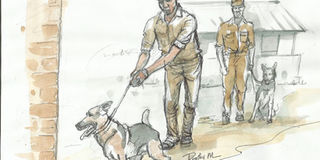Kiruhura murders: The evidence of an independent dog handler

Dr Sylvester Onzivua
What you need to know:
- Another challenge he pointed was a scenario where there were multiple bodies at different locations in a crime scene as was the case here. Peter emphasised that a dog cannot be introduced to multiple spots at the same time.
- It is important to understand the behaviour of tracking dogs. The dogs give peculiar alerts such as barking and tail wagging as signs of excitement. Urinating is, however, not part of the alerts.
Background
On the night of Friday, August 16, 2013, Daniel Karuhanga, a prominent cattle keeper and five of his workers, were brutally murdered at his home in Kiruhura District. The following day, two police dogs were introduced to the scene, to track the killer or killers.
The first dog and its handler arrived at the scene at about 10am after the crime scene had been cordoned off. But this team was ordered to wait for a more experienced dog and its handler.
The second team arrived shortly and the experienced dog was immediately introduced to the crime scene. The dog apparently tracked the scent up to the next homestead in which Jovia, the first wife of Karuhanga lived.
The dog then returned to the scene of murder and lost the scent at the spot where the killer or killers purportedly boarded a car and drove off. The tracking movements of the less experienced dog were almost identical to that of the second dog.
Police investigators arrested the Jovia on suspicion that she participated in the murder of her estranged husband. Her lawyers, however, countered the evidence the two dog handlers when they provided court with the evidence of an independent dog handler.
Dog trainer’s experience
Simon Peter, the independent dog trainer who testified as a defence witness, was 38 years old and had been working with dogs for 15 years. His initial training in handling dogs was in Uganda. It lasted for four months and his instructors were from South Africa.
He later worked for the US army in Iraq as a sniffer dog handler and in Mogadishu for the United Nations in Somalia in a similar capacity. He mentored the Somali dog handlers and established the first Dog Unit of the Somali Police.
His evidence
Simon Peter told court that human scent sniffer dogs are trained to track a human scent from a scene of crime. And before every operation, adequate preparations must be made including securing the crime scene and having adequate equipment.
It is imperative that the movements of the dog are video recorded as independent evidence of the dog’s movements for future reference, in case controversies arise.
He also told court that a crime scene should never be unduly contaminated or interfered with before a tracking dog is introduced. According to him, one person is enough to interfere with a crime scene because the dog actually picks the last scent at the scene.
Others factors which can interfere with the scent at a crime scene include extreme heat and other weather conditions, unnecessary movement of people within the vicinity and fatigue experienced by the dog.
It is important to note that human scent evaporates with time
Simon Peter said it is unprofessional to introduce more than one dog to a crime scene to track the same scent. A dog picks the last scent at a scene. When a second dog is introduced at a crime scene, it will most likely pick the scent of the first dog and its handler.
Another challenge he pointed was a scenario where there were multiple bodies at different locations in a crime scene as was the case here. Peter emphasised that a dog cannot be introduced to multiple spots at the same time.
It is important to understand the behaviour of tracking dogs. The dogs give peculiar alerts such as barking and tail wagging as signs of excitement. Urinating is, however, not part of the alerts.
It is basically a way of communication among dogs, a way of marking a territory and making one’s presence felt. When a dog urinates during a task as did one of the police dogs in this case, it is supposed to be disqualified.
Contamination of scene of crime
There was evidence that the crime scene in this particular case had been interfered with. Enid, who was working with Electoral Commission in Rushere and the wife of the first son of Karuhanga, told court that she received the news of the death of her father-in-law early morning of August 17, 2013 and immediately rushed to the scene.
She first went to her mother-in-law’s homestead and arrived at 8:30 am. She called loudly but nobody responded. She then walked to her father-in-law’s homestead using the shortcut by the kraals.
At the home of her father-in-law, the area had been cordoned off and she found very many people. She estimated the number to be about 300. Some of the people were inside the cordoned area while others were outside.
According to her testimony, many people continued coming to the crime scene and some followed the route she used. Three hours later, the police came with the dogs and the dogs followed the shortcut that she and other people had used to go to Karuhanga’s home.
Unfortunately, Enid was arrested when she went to make a statement at the police station and was in detention for two weeks. She was released on police bond and was never charged in courts of law.
Next week: How other suspects were arrested




